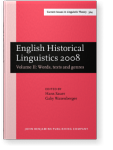Table of contents
Foreword & acknowledgements
List of abbreviations
Editors’ introduction: Explaining the development of the English vocabulary and analyzing characteristic features of English text types
Part I. Etymology
Etymology and the OED: The uses of etymology in a historical dictionary
On the etymological relationships of wank, swank, and wonky
Base etymology in the historical thesauri of deverbatives in English
Part II. Semantic fields
The global organization of the English lexicon and its evolution
Repayment and revenge: Metaphorical or metonymic links between two semantic fields
Semantic change in the domain of the vocabulary of Christian clergy
Part III. Word-formation
Abstract noun ‘suffixes’ and text type in Old English
The lexicalisation of syncope: Derivational affixes in West Saxon adjectives
Oriented -ingly adjuncts in Late Modern English
Part IV. Textlinguistics, text types, politeness
Historical text linguistics: Investigating language change in texts and genres
Repetitive and therefore fixed? Lemmatic bundles and text-type standardisation in 15th-century administrative Scots
Politeness strategies in Late Middle English women’s mystical writing
A diachronic discussion of extenders in English remedies found in the Corpus of Early English Recipes (1350–1850)
“It is with a trembling hand I beg to intrude this letter”: Politeness in the pauper letters of 18th century England
Genre analysis: Changes in Research Article introductions
Index
This article is available free of charge.
